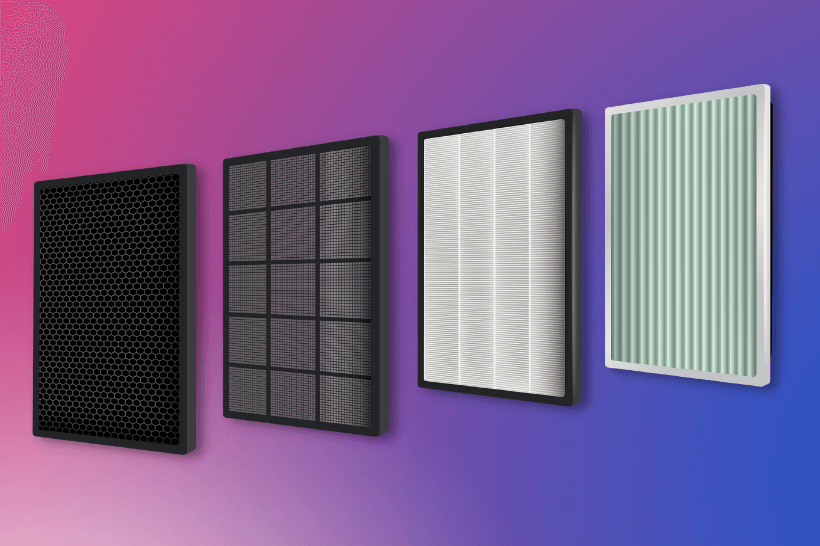Do you find purchasing an air filter for your home a harrowing experience? Part of the confusion surrounding air filters is the various rating systems and their numerical scales. Let’s take a look at the purpose of filter rating systems, the three most popular systems and how they compare.
What Are Filter Ratings?
Filter ratings assess the efficacy and efficiency of air filters with regard to their ability to remove microparticles and macroparticles from indoor air, thus improving air quality. In other words, some air filters are more powerful than others and may better serve residences depending upon specific conditions (e.g., pets, allergies, occupants, maintenance). While filter ratings are designed to help homeowners choose the best fit for their home, they unintentionally cause confusion.
MERV vs. MPR. vs. FPR Rating Systems
MERV
The minimum efficiency reporting value (MERV) rating system was developed by the American Society of Heating, Refrigerating and Air Conditioning Engineers (ASHRAE). The system measures an air filter’s ability to capture particles between 0.3 and 10 micrometers in size. The MERV rating system rates filters on a scale from 1 to 20. However, filters with a rating higher than 16 are unnecessary for residential homes. The MERV ratings and their capabilities are as follows:
- MERV 1–4: These filters are able to capture pollen, dust mites and textile fibers.
- MERV 5–8: These filters are able to capture pollen, dust mites, textile fibers, mold spores, hair spray and dust from cement.
- MERV 9–12: These filters are able to capture the aforementioned pollutants in addition to exhaust fumes, milled flour and dust from lead.
- MERV 13–16: These filters are powerful enough to capture bacteria, tobacco smoke and particles from a sneeze.
 Home Air Filters: Looking to better understand MERV ratings and how to choose the best filter for your home? We break down all things MERV here →
Home Air Filters: Looking to better understand MERV ratings and how to choose the best filter for your home? We break down all things MERV here →MPR
The microparticle performance rating (MPR) system was developed by the company 3M in order to measure an air filter’s ability to capture microparticles between 0.3 and 1 micrometers. 3M’s rating system took a similar approach to MERV, but the system only applies to air filters manufactured by 3M. MPR rates filters on a scale from 100 to 2,800. A sample of the MPR ratings and their capabilities are as follows:
- MPR 300: These filters are not very powerful and only have the ability to capture dust and lint.
- MPR 600: These filters have the ability to capture dust, lint, debris from dust mites, pollen and mold spores.
- MPR 1,000: These filters have the ability to capture the aforementioned in addition to dander, smoke and smog.
- MPR 1,500: These filters have the ability to capture some of the trickiest particles including those from bacteria and viruses.
- MPR 2,200: These filters are very powerful and have the ability to capture large particles and small particles such as candle soot, PM 2.5 and exhaust fumes.
FPR
The filter performance rating (FPR) system was developed by The Home Depot to measure an air filter’s ability to capture particles. Similar to MPR, this rating system only applies to air filters sold by The Home Depot. The FPR system rates filters on a scale from 1 to 10. However, it’s important to note that filters with a rating below four are unable to trap even common household particles such as dust and lint. The FPR ratings and their capabilities are as follows:
- FPR 4-5 (Green = Good): These filters are able to capture large particles such as dust, dust mites, lint, pollen and dander.
- FPR 6-7 (Red = Better): These filters are able to capture large particles and small particles such as bacteria and mold spores.
- FPR 8-9 (Purple = Best): These filters are able to capture large particles, small particles, smoke, smog, microscopic allergens and particles that carry viruses.
- FPR 10 (Black = Premium): These filters are able to capture all of the aforementioned in addition to particles that carry odors.
Do Filter Rating Systems Matter?
Yes, of course they do! As aforementioned, the MPR system and the FPR system are specifically associated with the brands 3M and Home Depot, respectively. However, the MERV rating system is universal, making it much easier for homeowners to compare when searching for an air filter. All air filter efficiencies and capabilities can be understood with the MERV rating system.
The MPR and FPR systems are only helpful when applied to their respective brands. The MERV rating system is beneficial for homeowners looking to switch air filter brands or compare available choices. If that statement resonates with you, take a look at the two comparison charts below. But—keep in mind that these comparisons are broadly based on particle removal percentages.
The following chart explains the relationship between the numerical scales of the MERV rating system and the MPR system.
| MERV | MPR |
|---|---|
| 5 | ~300 |
| 7 | ~600 |
| 11 | ~1,000 |
| 12 | ~1,500 |
| 13 | ~1,900 |
The following chart explains the relationship between the numerical scales of the MERV rating system and the FPR system.
| MERV | FPR |
|---|---|
| 6–8 | ~4–5 |
| 8–11 | ~6–7 |
| 11 | ~8–9 |
| 13 | ~10 |
Choose Your Air Filter Wisely
Overall, each of the aforementioned filter rating systems can be helpful for homeowners. Each provides a breakdown of an air filter’s ability and a comparison measure based on the rating. Whether you choose the MERV rating system, the MPR system or the FPR system, be sure to choose an air filter with an appropriate rating given the conditions in your home. If you have pets and allergies, an air filter with a low rating will be of no assistance.
Of course, choosing MPR or FPR is only possible if you shop at 3M or The Home Depot. This is again why MERV, the industry-accepted air filtration standard, is the ideal air filter comparison rating system to use.
 Ditch the dust and allergens! MERV 13 filters offer superior air quality by trapping microscopic particles like pollen, mold spores, and even some bacteria. Breathe easier and live healthier – Shop MERV 13 Air Filters →
Ditch the dust and allergens! MERV 13 filters offer superior air quality by trapping microscopic particles like pollen, mold spores, and even some bacteria. Breathe easier and live healthier – Shop MERV 13 Air Filters →Looking to upgrade your home air filter? MERV 13 is our favorite, but anything MERV 11+ signifies a healthy home. We can help you find a qualified IAQ expert in your area to help determine the best filter for your space today.




